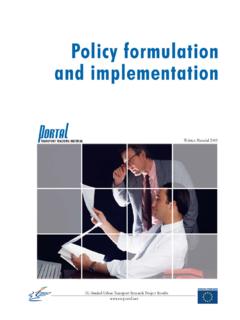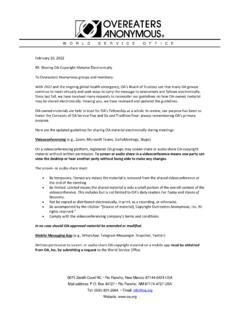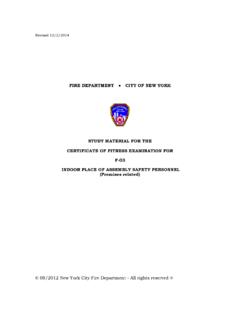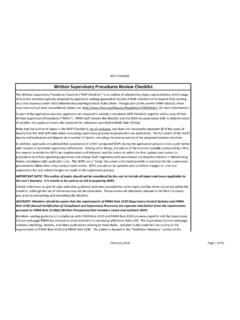Transcription of Toolkit for Making Written Material Clear and Effective
1 Toolkit for Making Written Material Clear and Effective SECTION 4: Special topics for writing and design PART 7 Using readability formulas: A cautionary note Department of Health and Human services Centers for medicare & medicaid services Toolkit Part 7 Using readability formulas: A cautionary note Introduction Background on the Toolkit ..1 What are readability formulas ? ..1 Reasons for caution Why be cautious about using readability formulas? ..4 Reason for caution1: Readability formulas ignore most factors that contribute to ease of reading and Reason for caution 2: Grade level scores tend to be Reason for caution 3: Grade level scores are less precise than they sound and prone to Reason for caution 4: Imposing a grade level requirement has the potential to do harm.
2 14 Recommendations Recommendations for using readability Recommendation 1: Do not use readability formulas to assess overall Recommendation 2: Pick your formula and method carefully ..19 Recommendation 3: Interpret reading grade level scores broadly as indicating a general range of difficulty ..22 Recommendation 4: Report grade level scores in ways that acknowledge their narrow scope and limitations ..24 Instructions for using readability formulas Instructions for using the Fry method ..28 Instructions for using the SMOG ..35 End notes ..38 List of figures: Figure 7-a. What grade level do you think it is? ..2 Figure 7-b. Reasons for caution in using readability formulas ..4 Figure 7-c. Readability formulas ignore the active role of the reader.
3 6 Figure 7-d. Readability formulas alone can t tell you whether Written materials are Clear and Effective ..8 Figure 7-e. What does a readability score actually mean?..13 Figure 7-f. Recommendations for using readability Figure 7-g. The Fry Method and the SMOG at a Figure 7-h. Interpreting scores from readability formulas as ranges of Figure 7-i. Example of reporting the scores from readability formulas ..25 Figure 7-j. Instructions for using the Fry Method by hand to score Figure 7-k. An example that applies the Fry Method to a sample of Figure 7-l. Instructions for using the SMOG to score text ..35 This document is Part 7 of the Toolkit for Making Written Material Clear and Effective . The Toolkit has 11 Parts. It was Written for the Centers for medicare & medicaid services (CMS) by Jeanne McGee, PhD, McGee & Evers Consulting, Inc.
4 The guidelines and other parts of the Toolkit reflect the views of the writer. CMS offers this Toolkit as practical assistance to help you make your Written Material Clear and Effective (not as requirements from CMS). Toolkit for Making Written Material Clear and Effective SECTION 4 Special topics for writing and design Part 7: Using readability formulas: A cautionary note 1 Background on the Toolkit This document, Toolkit Part 7, is part of the Toolkit for Making Written Material Clear and Effective . To provide context for this document, we begin with background on the Toolkit as a whole. The Toolkit is an 11-part health literacy resource (see Toolkit Part 1). It s a detailed and comprehensive set of tools to help you make Written Material easier for people to understand and use. This Toolkit is from the Centers for medicare & medicaid services (CMS) and it is oriented toward the programs administered by CMS.
5 These programs include medicare , medicaid , and the Children s Health Insurance Program (CHIP). In this Toolkit , we focus on Material in printed formats that is Written for people with medicare or medicaid and the parents or guardians of children with coverage through CHIP. These CMS audiences are culturally, linguistically, and demographically diverse, and they include significant numbers of people with low literacy skills. Much of the discussion in the Toolkit also applies to Material that is Written for those who work with or assist members of CMS audiences, such as Material Written for family members of people with medicare , outreach workers, agency staff, community organizations, and care providers. To help you develop or revise your Written Material , the Toolkit includes detailed guidelines for writing and design.
6 There are 26 guidelines for writing in Toolkit Part 4 and 46 guidelines for graphic design in Toolkit Part 5. For background on this Toolkit , see Toolkit Part 1, About the Toolkit and how it can help you, and Toolkit Part 2, Using a reader-centered approach to develop and test Written Material . For the full list of guidelines for writing and design, and a discussion about how to use them, see Toolkit Part 3, Summary List of the Toolkit Guidelines for Writing and Design . What are readability formulas ? The topic of Toolkit Part 7 is readability formulas. These are formulas that are used to measure difficulty of the vocabulary and sentences in Written materials. There are several dozen readability formulas, including the Fry formula, SMOG, and Flesch tests (Flesch-Kincaid and Flesch Reading Ease).
7 Though the formulas vary, they estimate difficulty based on what is easy to count at the level of individual words and sentences, such as the length of words and sentences. Results from these formulas are often given as a grade level, such as fourth grade or 12th grade. To illustrate how word choices and sentence length can affect ease of reading, Figure 7-a shows similar content Written at three different grade levels. See if you can guess the grade levels. Notice the variations from version to version in vocabulary and sentence length. Toolkit for Making Written Material Clear and Effective SECTION 4 Special topics for writing and design Part 7: Using readability formulas: A cautionary note 2 7-a. What grade level do you think it is? Paragraph A Paragraph B Toolkit for Making Written Material Clear and Effective SECTION 4 Special topics for writing and design Part 7: Using readability formulas: A cautionary note 3 Paragraph C Answer: Approximate grade levels are: A.
8 12th grade. B. 8th grade. C. 4th grade. Source: Exercise 9 in Write It Easy-to-Read (Root & Stableford, 1998). Used with permission of Sue Stableford, Health Literacy center , University of New England, Biddeford, Maine. Using readability formulas in meaningful ways To use readability formulas in meaningful ways, you need to keep in mind what they actually measure and be aware of concerns and cautions raised by specialists in the field. In this document, we summarize reasons for caution in using readability formulas and offer recommendations for using them. We also give step-by-step instructions for scoring Material by hand using methods we recommend (the Fry Method and the SMOG). If you use a computerized readability formula to do machine scoring of a document, you will need to prepare the text first for more accurate scoring.
9 We include tips on how to do this. Toolkit for Making Written Material Clear and Effective SECTION 4 Special topics for writing and design Part 7: Using readability formulas: A cautionary note 4 Why be cautious about using readability formulas? Sections that follow discuss the cautions that are listed below in Figure 7-b. 7-b. Reasons for caution in using readability formulas. Readability formulas ignore most factors that contribute to ease of reading and comprehension, including the active role of the reader. Relying on a grade level score can mislead you into thinking that your materials are Clear and Effective when they are not. Grade level scores for the same text can differ considerably depending on the formula you choose and how you use it. Grade level scores are less precise than they sound and it is tempting to over-interpret what they mean.
10 Imposing a grade level requirement has the potential to do harm. To make text score at a lower grade level, you have to shorten words and sentences. Sometimes this improves ease of reading, but it can also lead to edits that reduce the ease of reading. For example, writers might remove familiar words just because they are long. Overall, the need to meet a grade level requirement can lead writers to produce text that is choppy and lacks cohesion. Source: Created for this Toolkit . This list of cautions and the discussion of each caution reflect themes in the references and resources listed at the end of this document, as well as suggestions from subject matter experts listed in the acknowledgments. They also draw on discussion in the precursor to this Toolkit titled Writing and Designing Print Materials for Beneficiaries: A Guide for State medicaid Agencies, which was published in 1999 by the Health Care Financing Administration (HCFA, known today as CMS); now out of print.
















